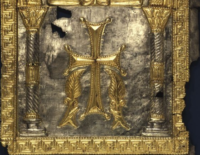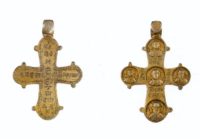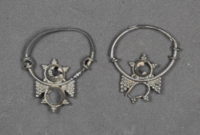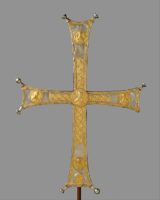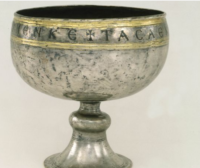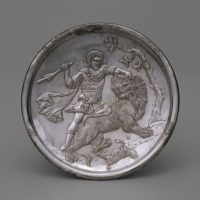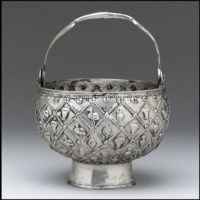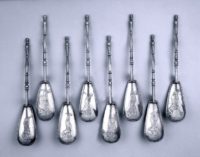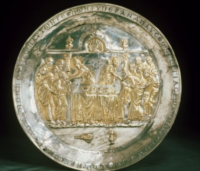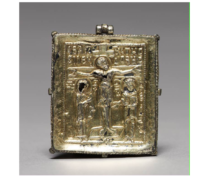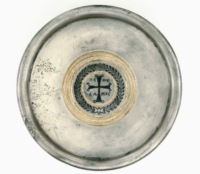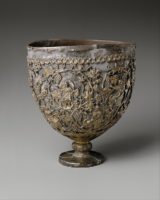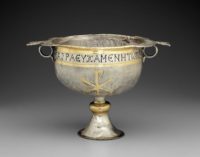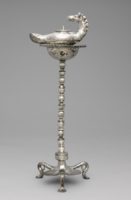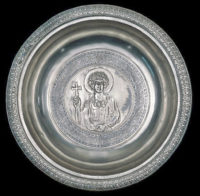Book Cover with a Cross Flanked by Cypress Trees, Period: Early Byzantine, circa: Mid 6th Century. The museum is open to the public Tuesday through Sunday, 11:30 a.m.–5:30 p.m., except for federal holidays.
Pectoral cross with busts of Jesus Christ and saints, silver-gilt. On the reverse, the engraved inscription refers to its owner: Epiphanios. Period: Middle Byzantine; circa: 11th c. The Benaki Museum of Greek Culture is housed in one of the most beautiful neoclassical-style buildings in Athens, near the National Garden and the Hellenic Parliament.
Medal of Emperor Constantine The Great, Period: Early Byzantine circa: 4th century, Materials: silver. On view at ” Raum-1 Medaillen”. The Museum is one of the oldest collections of its kind in Europe. Its beginnings date back to the second half of the 16th century.
Pair of earrings, Period: Middle Byzantine (10thC-11thC). Material: silver. Diameter: 3.4 centimetres (max). British Museum is closed 24, 25 and 26 December and 1 January, but is open every other day of the year. Fast facts about the British Museum: Founded: 1753, Collection size: 8 million objects, Oldest object in the collection: Stone chopping tool (nearly 2 million years old).
Pendant Icon with the Virgin “Dexiokratousa” and Frame with Winged Bull of Saint Luke on the back, Pendant 1100s; Frame mid. Period: Middle Byzantine. Materials: Steatite, Gilt silver, Pearls. The Cleveland Art Museum Hours: Tuesdays, Thursdays, Saturdays, Sundays 10:00 a.m.–5:00 p.m. Wednesdays, Fridays 10:00 a.m.–9:00 p.m. Closed Mondays.
Processional Cross, Period: Middle Byzantine, circa: 1000–1050, Materials: Silver, silver-gilt. On view at The Met Fifth Avenue in Gallery 303. Inscription: in Greek: (on the back medallions) Saint Thalelaios, Saint Nicholas, [initials for] Saint John Chrysostom, Uriel, Raphael; (on foot) supplication of Leo, bishop (on the front medallions) [initials for] Jesus Christ, [initials for] Mother of God, [initials for] John the Forerunner, Michael, Gabriel. The Metropolitan Museum of Art (New York) is one of the world’s largest and finest art museums. Its collection includes more than two million works of art spanning five thousand years of world culture, from prehistory to the present and from every part of the globe. Public Hours: 10:30 a.m.–5:30 p.m. Open seven days a week.
Chalice, Period: Early Byzantine, ca. 527 – 565 A.D. Materials: silver and niello. The museum is open to the public Tuesday through Sunday, 11:30 a.m.–5:30 p.m., except for federal holidays.
Plate with David Slaying a Lion, Period: Early Byzantine, circa: 629–630, Materials: Silver, Made in Constantinople, The Metropolitan Museum of Art (New York) is one of the world’s largest and finest art museums. Its collection includes more than two million works of art spanning five thousand years of world culture, from prehistory to the present and from every part of the globe. Public Hours: 10:30 a.m.–5:30 p.m. Open seven days a week.
Two Thirds of Miliarensis, Minted in Constantinople. Period: Middle Byzantine, circa: 1042-1055. Ruler: Constantine IX Monomachos. Material: silver. The collection of the State Hermitage includes over 3 million works of art and world culture artefacts. It contains paintings, graphic works, sculptures, works of applied art, archaeological artefacts and numismatic objects. The Hermitage is considered to have been founded in 1764, when Empress Catherine the Great acquired an impressive collection of works from the Berlin merchant Johann Ernst Gotzkowsky. The museum celebrates the anniversary of its founding each year on 7 December, St. Catherine’s Day. Opening Hours: Tuesday, Thursday, Saturday, Sunday: 10.30-18.00 Wednesday, Friday: 10.30-21.00 Closed: Monday.
Icon Frame, Period: Middle Byzantine, circa: Mid-11th century. Size: 22 x 20 (8.7 x 7.9). Materials: enamel on gilt silver. The museum is open to the public Tuesday through Sunday, 11:30 a.m.–5:30 p.m., except for federal holidays.
Silver Bucket, Period: Early Byzantine circa: 600s. Made in Tirana, Modern Albania. (Found in Vrap) Material: Silver. On view at The Met Fifth Avenue in Gallery 301. The Metropolitan Museum of Art (New York) is one of the world’s largest and finest art museums. Its collection includes more than two million works of art spanning five thousand years of world culture, from prehistory to the present and from every part of the globe. Public Hours: 10:30 a.m.–5:30 p.m. Open seven days a week.
Loop earring; Materials: silver; Period: Middle Byzantine: 10thc-11thc. Length: 51 millimetres Weight: 12.2 grammes. British Museum is closed 24, 25 and 26 December and 1 January, but is open every other day of the year. Fast facts about the British Museum: Founded: 1753, Collection size: 8 million objects, Oldest object in the collection: Stone chopping tool (nearly 2 million years old).
Silver spoon, Period: Early Byzantine; 650 (circa). Found: Acheripoetos Monastery, monastery (near)(Europe,Cyprus,Nicosia (district),Kyrenia,Acheripoetos Monastery) British Museum is closed 24, 25 and 26 December and 1 January, but is open every other day of the year. Fast facts about the British Museum: Founded: 1753, Collection size: 8 million objects, Oldest object in the collection: Stone chopping tool (nearly 2 million years old).
Paten with the Communion of the Apostles, Period: Early Byzantine (565-578 A.D.) Materials: silver, gilding and niello. The museum is open to the public Tuesday through Sunday, 11:30 a.m.–5:30 p.m., except for federal holidays.
Enkolpion with the Crucifixion (front) and Saints Theodore and George (back), silver gilt and cloisoné enamel, Period: Middle Byzantine, 1080-1120. Constantinople. The Cleveland Art Museum Hours: Tuesdays, Thursdays, Saturdays, Sundays 10:00 a.m.–5:00 p.m. Wednesdays, Fridays 10:00 a.m.–9:00 p.m. Closed Mondays.
Plate with Cross and Greek Inscription ‘Hope of God’, Period: Early Byzantine, 7th century A.D. The museum is open to the public Tuesday through Sunday, 11:30 a.m.–5:30 p.m., except for federal holidays.
The Antioch Chalice, Period: Early Byzantine, circa: 500–550, Made in Antioch or Kaper Koraon, Materials: Silver, silver-gilt. On view at The Met Fifth Avenue in Gallery 300. The Metropolitan Museum of Art (New York) is one of the world’s largest and finest art museums. Its collection includes more than two million works of art spanning five thousand years of world culture, from prehistory to the present and from every part of the globe. Public Hours: 10:30 a.m.–5:30 p.m. Open seven days a week.
Silver Chalice, Period: Early Byzantine, circa: 6th century A.D. Dimensions: Height (max.): 18 cm. (7 1/16 in.); Width (max. at handles): 26.6 cm (10 1/2 in.); Width (bowl): 16 cm (6 5/16 in.).
The cup has actually ring handles topped by flat plates of lunate kind with trapezoidal forecasts in the line of the handles. An inscribed band in between the manages is flanked by a gilded profiled rim (above) and a gilded profiled band listed below. The body is hemispherical. The high foot includes a concave, then round stem and a cone-shaped assistance with broad, horizontal flange listed below. The niello-inlaid engraving (in Greek uppercase) equates: “Sarah hoped and made [this] using to the First Martyr” (Saint Stephen). Likewise (each side) is a gilded Christogram made up of a chi and rho (the very first 2 letters of Christ’s name in Greek) flanked by alpha and Omega. These are the first and last letters of the Greek alphabet, symbolizing that Christ is the beginning and end of all things. Locations of the bowl are completed; foot is corrected and repaired.
The MFA is open 7 days a week. Monday and Tuesday 10 am–5 pm, Wednesday–Friday 10 am–10 pm, Saturday and Sunday 10 am–5 pm.
Lamp and Stand, Period: Early Byzantine, 4th century. Materials: Silver. 9.2 x 16 x 7 cm (3 9/16 x 6 1/4 x 2 3/4 in.). The Cleveland Art Museum Hours: Tuesdays, Thursdays, Saturdays, Sundays 10:00 a.m.–5:00 p.m. Wednesdays, Fridays 10:00 a.m.–9:00 p.m. Closed Mondays.
Bowl; circular medallion with half-figure of a nimbed saint, St Sergios. Period: Early Byzantine; circa: 641-651; Materials: Silver. Production place: Made in Tarsus, Anatolia (Modern Turkey). Found: Acheripoetos Monastery, Cyprus,Nicosia. British Museum is closed 24, 25 and 26 December and 1 January, but is open every other day of the year.
Fast facts about the British Museum: Founded: 1753, Collection size: 8 million objects, Oldest object in the collection: Stone chopping tool (nearly 2 million years old).


